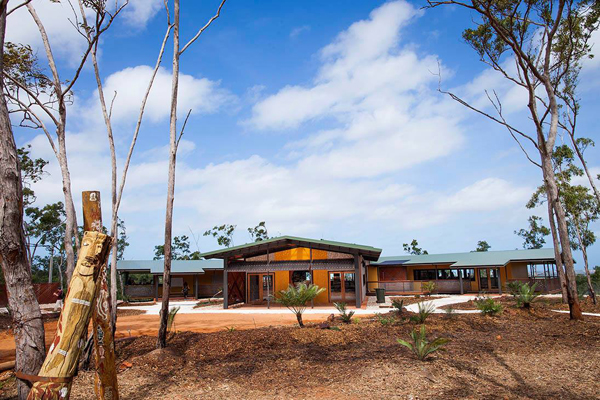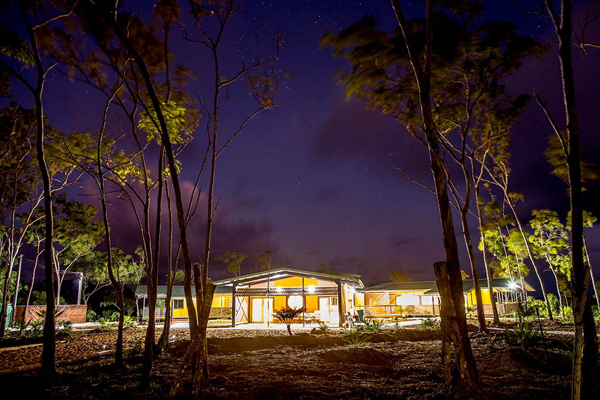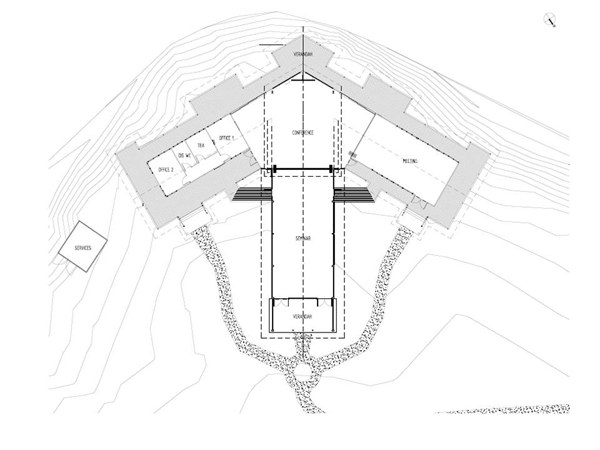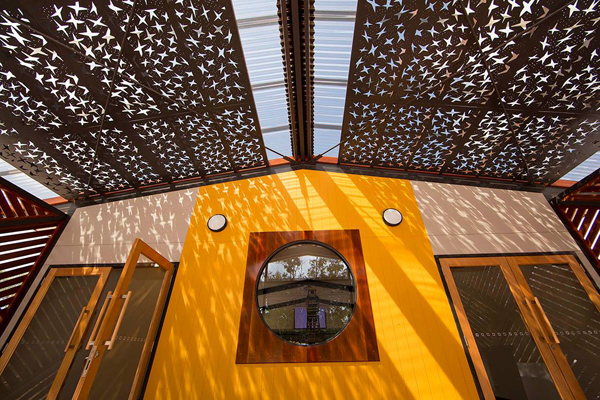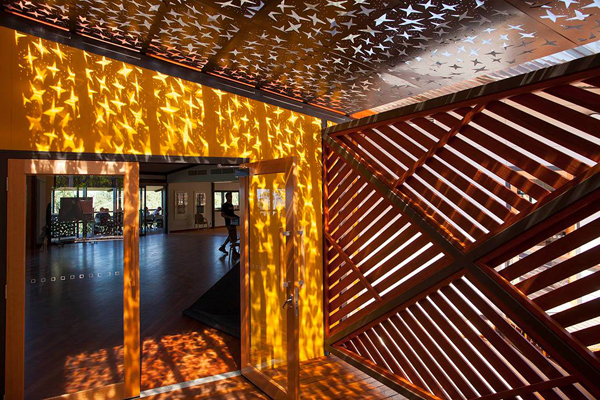
The Garma Cultural Knowledge Centre
The Garma Cultural Knowledge Centre
Share
Article by Dr Elizabeth Grant. Photographs by Peter Eve and drawings by Build Up Design Architects Darwin.
The Yolngu people of north-east Arnhem Land in Australia have a tradition of overlaying and blending their culture with the ideas, customs and social behaviour of other societies to achieve positive outcomes and autonomy. The recently completed Garma Cultural Knowledge Centre at Gulkula expresses Yolngu knowledge, power and identity through the medium of contemporary architectural design.
Gulkula in north-east Arnhem Land is located 600 kilometres east of Darwin. The site stands on the Dhupuma escarpment amid a grey stringy bark forest, overlooking the Gulf of Carpentaria with views to the intricate matrix of serpentine watercourses meandering into the Arafura Sea. For Yolngu and others, Gulkula is a profound and sacred place. Mungurrawuy Yununpingu described Gulkula as “an all-encompassing philosophical, physical, cosmological, theoretical place”.
Ceremonies have been performed at Gulkula since time immemorial. In 1999, a gathering of Yolngu Elders established the Garma Festival at the site to encourage the practice, preservation and maintenance of Yolngu dance, song, art and ceremony. The festival has grown to a national and international gathering of political, cultural and academic significance. The construction of permanent building on the site was intended to enable further activities at the site. The Garma Cultural Knowledge Centre operates as an adult learning centre, meeting place and as a ‘keeping house’ to house and showcase cultural artefacts.
Architect Simon Scally (Build Up Design Darwin) received instructions that the floor plan for building was to take “…the form of an anchor and the building was to be placed as close as possible to the edge of the escarpment”. The resultant steel framed building (clad with colourbond and cement sheeting) surrounded by timber verandas (constructed of locally sourced and milled grey stringy bark) is sited to afford spectacular views of the Gulf.
The floor plan is the shape of an anchor consisting of a crown, arms, shank and ring. The shank of the anchor houses an auditorium designed to accommodate up to 150 people with the base of the shank housing the meeting area. One arm houses administration services while the other arm contains the learning area. A round window situated the front of the building subtly references the ‘ring’ of the anchor. The floor plan is hierarchical. The meeting room where clan leaders meet is located at the apex of the building commanding a significant view. The learning area has a view to allow Yolngu students to be taught with the culturally significant landscape in view. The building can be opened up to hold large functions and is designed to support and encourage Yolngu preferences, needs and cultural etiquette.
The floor plan of the building is culturally significant. Gumatj clan leader, Galarrwuy Yunupingu, AM explains, ‘The anchor represents unity and strength. It anchors Yolngu to our land and makes real our ties to the ceremonial meeting ground at Gulkula.”
The symbol of the anchor is embedded in Yolngu oral traditions. Macassar traders visited north-east Arnhem Land regularly from 1780 onwards and built relationships that are celebrated in Yolngu art, songs and stories. The anchor is integral to the story of Bayini, who sailed to Arnhem Land centuries ago and symbolises strength, unity and Yolngu connection to country.
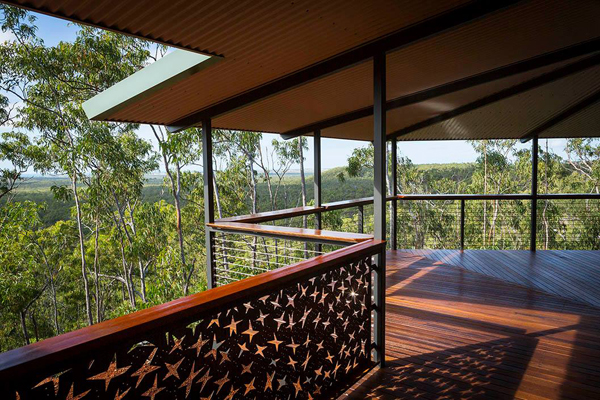
Yunupingu’s work, Garak reinterpreted as metal panels for the veranda of the Garma Cultural Knowledge Centre
The exterior of the Garma Cultural Knowledge Centre is predominately, yellow and dark red. Panels of the building are painted yellow to replicate the colour of the ochre representing the blood of the Yirritja moiety. The timber of the building is a dark red which represents the blood of the Dhuwa moiety. For ceremony, Yolngu apply ochres in these colours in a sacrament that is said to renew and strengthen the blood of participants. Each clan also has a colour and yellow is the hue of the Gumatj clan, the owners of the land upon which the Garma Cultural Knowledge Centre is built.
Yolngu art is unique in that it simultaneously expresses people’s social identities, ancestral law and ownership of land. Interpretations of the late Ms Gulumbu Yunupingu’s work, Garak, The Universe were translated into a series of laser cut corten steel panels. “The work is about the entire universe, all the stars that can be seen by the naked eye, and also everything that exists far beyond any scientific expedition or estimation – everything that can be imagined and all that cannot.” The perforated panels are installed along the balconies and as roof panels and the artwork is brought into the building in shadow relief with light and shade changing the qualities of the work throughout the day and night.
The clients developed a creative synthesis with the architect, using the architecture as a medium to tell their stories. This required the architect to surrender some elements of the design process to Yolngu direction. For Yolngu, to lose traditions would be to lose the functional logic through which ancestral law is exercised and the human experience is sanctified. Efforts to sustain the unique traditions amid the underlying fiscal poverty of remote Australia, economic and political pressures and personal pressures from within are nothing short of heroic. The Garma Cultural Knowledge Centre dispels any notion that Yolngu that may be alienated, disempowered or subjugated in their engagement with non-Aboriginal culture. This is a project which celebrates Yolngu achievement and endeavour.
The next Garma Festival will take place at Gulkula from 31 July – 3 August 2015. For more information on the festival, the Yothu Yindi Foundation and their work see here.
Dr Elizabeth Grant is an architect, anthropologist and academic at the University of Adelaide specialising in the research and design of environments for Aboriginal and Torres Strait Islander peoples.
To read more of Dr Grant’s work, check out her article on Indigenous representation at Kunanurra Court House.
You Might also Like


